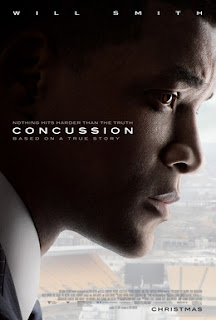Opening this weekend:
In the Heart of the Sea—In 1820, the Nantucket whaler
Essex was attacked by
a sperm whale in the Pacific, thousands of miles west of South America. It
sank, and the crew went through hell and resorted to extreme measures to stay
alive. Ron Howard has tried to turn Nathaniel Philbrick’s acclaimed 2000
account of this awful trip, one of the inspirations for
Moby-Dick, into a
psychologically and spiritually fraught adventure in its own right.
As usual with Howard, it’s a well-made movie with many rousing scenes. The
whale effects are mostly very good and convincing, and the actors do solid,
respectable work. But the movie doesn’t come off, overall.
Chris Hemsworth plays Chase, the first mate, at Melvillian odds with the
haughty novice Captain, Pollard (Benjamin Walker, nicely restrained in a
thankless role). The product of a venerable whaling family, Pollard resents the
effortless seamanship of Chase, the son of a “landsman.”
This conflict becomes moot when a huge, patchy-white sperm whale decides to
go Zidane on the hull of the
Essex. I must confess that I enjoyed the leviathan’s
vengeance more than anything else in
ITHOTS. I felt good for the beast, much
the way one might feel good for Charles Bronson in a
Death Wish movie.
I found it hard to sympathize with whalers, not because they weren’t
courageous and skillful but because I brought a 21
st-Century sense
of their enterprise as an environmental atrocity into the movie with me. I
realize that this response is pious hindsight, and that our age doesn’t have
any real right to feel superior about how we light our cities, that indeed in
the grand scheme of things it’s probably a far greater blight on the planet
than hunting a few sea mammals to the brink of extinction. It may come down to Orwell’s
observation in “Shooting an Elephant”: “Somehow it always seems worse to kill a
large animal.”
But whatever the reason, it interfered with my enjoyment of
ITHOTS. I think
Howard and screenwriter Charles Leavitt anticipated it too. They’ve toned down
the horror wrought by the
Essex crew, omitting, for instance, their
ecologically disastrous visit to the Galapagos, and giving Chase’s final
encounter with the whale an ambiguity that falls flat as drama. Melville turned
this story into an astonishing, exasperating myth, an allegory that transcends
and almost reproaches the very idea of allegory. But
ITHOTS is just one more
story about The One That Got Away.
Opening this weekend at Harkins Valley Art in Tempe:
Don Verdean—Sam Rockwell plays the title character, an evangelical
archaeologist who claims to have unearthed such relics as the shears used to
cut Samson’s hair. Bankrolled by a preacher (Danny McBride) anxious over his
dwindling flock, Don travels to Israel in search of the skull of Goliath. Under
pressure from his patron, and abetted by his unscrupulous local digger Boaz
(Jermaine Clement), Don, who sincerely wants to save souls, gradually succumbs
to the temptation to fake this discovery. Of course, things only get wackier
and worse from there, as Don and Boaz eventually agree to provide a buyer with
the “Holy Grail of Biblical artifacts,” which is, of course, the Holy Grail.
This is the latest from Jared Hess of
Napoleon Dynamite, again from a script
co-written with his wife Jerusha. As with their other post-
Napoleon films,
Nacho Libre and
Gentlemen Broncos, it’s seriously uneven. The Hess touch, so to
speak, is all about awkward pauses and fitful, off-kilter bursts of slapstick action,
and when it works it’s punishingly funny, and when it doesn’t, it just hangs
there on the screen, not working.
The acting is terrific, however. McBride and Will Forte ham it up a bit more
than they have to as the rival preachers, but Clement takes the opportunity, as
he did in
Gentlemen Broncos, to deploy another shamelessly silly accent. Amy
Ryan gives us so much subtext as Don’s adoring assistant that she’s almost too
touching for the farcical tone.
And as usual, Rockwell is a marvel. His Don hides his poker face behind a
thick beard, speaking in a firm, sober drawl—he sounds like George W. Bush
mixed with Johnny Cash—and authoritatively puts everyone at ease. In their
ridiculous way, Rockwell and Hess offer a plausible, even somewhat affectionate
portrait of how a decently-intentioned person could allow himself to be
corrupted.
Opening this weekend at Harkins Shea:
Hitchcock/Truffaut—This documentary is both a film version of and a tribute
to the famous 1966 book-length interview of Alfred Hitchcock by the young Francois
Truffaut. Familiar to just about every film geek of the ‘60s and ‘70s, the tome
is credited with helping to change the perception of Hitchcock as a talented
craftsman and entertainer to that of an artist.
Thus the movie, directed by Kent Jones, features talking heads ranging from
Wes Anderson to Richard Linklater to Kiyoshi Kurosawa to Martin Scorcese,
talking not only about how much they love Hitchcock and Truffaut but also about
how much they loved the book. We get clips from the movies, and audio clips of
the interviews, and a little narration, by Bob Balaban.
So what’s not to like? Nothing; it’s a fine way to spend 80 minutes. But as
with the best documentaries about cinema, it’s an appetizer—it leaves you
hungry for whole movies.


































